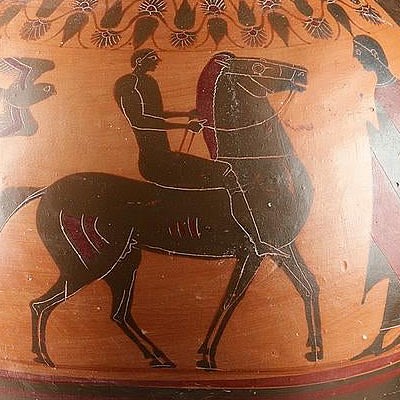Published / Large Egyptian Bronze Ram's Horn Lapis
Lot 8a
About Seller
Artemis Fine Arts
686 S Taylor Ave, Ste 106
Louisville, CO 80027
United States
Selling antiquities, ancient and ethnographic art online since 1993, Artemis Gallery specializes in Classical Antiquities (Egyptian, Greek, Roman, Near Eastern), Asian, Pre-Columbian, African / Tribal / Oceanographic art. Our extensive inventory includes pottery, stone, metal, wood, glass and textil...Read more
Estimate:
$8,000 - $12,000
Absentee vs Live bid
Two ways to bid:
- Leave a max absentee bid and the platform will bid on your behalf up to your maximum bid during the live auction.
- Bid live during the auction and your bids will be submitted real-time to the auctioneer.
Bid Increments
| Price | Bid Increment |
|---|---|
| $0 | $25 |
| $300 | $50 |
| $1,000 | $100 |
| $2,000 | $250 |
| $5,000 | $500 |
| $10,000 | $1,000 |
| $20,000 | $2,500 |
| $50,000 | $5,000 |
| $100,000 | $10,000 |
| $200,000 | $20,000 |
About Auction
By Artemis Fine Arts
Jun 4, 2020
Set Reminder
2020-06-04 10:00:00
2020-06-04 10:00:00
America/New_York
Bidsquare
Bidsquare : Exceptional Antiquities, Asian, Ethnographic
https://www.bidsquare.com/auctions/artemis-gallery/exceptional-antiquities-asian-ethnographic-5185
An important one-day auction featuring museum-worthy examples of Egyptian, Greek, Roman, Etruscan, Near Eastern, Far East / Asian, Pre-Columbian, African / Tribal, Oceanic, Native American, Spanish Colonial, Russian, Fossils, Ancient Jewelry, Fine Art, so much more! Artemis Fine Arts info@artemisgallery.com
An important one-day auction featuring museum-worthy examples of Egyptian, Greek, Roman, Etruscan, Near Eastern, Far East / Asian, Pre-Columbian, African / Tribal, Oceanic, Native American, Spanish Colonial, Russian, Fossils, Ancient Jewelry, Fine Art, so much more! Artemis Fine Arts info@artemisgallery.com
- Lot Description
Ancient Egypt, Third Intermediate Period, XXIst Dynasty, ca. 1069 to 945 BCE. Wow! A stunning, near-lifesize cast bronze ram's horn with dozens of beautiful lapis lazuli inlays that create the striated exterior surface of the horn. The graceful curve of the horn, with a thick tang on the back side of its widest end, would have once fit neatly into a cult image of Amun, who in some incarnations wore a ram horn headdress. The undecorated interior gives us an idea of how it would have sat close to the god's head, which may have also been bronze, or could have been carved of stone. Cult images of gods stood outside temples and were also used in processions in ancient Egypt. See, for example, the granite statue of Amun in the form of a ram protecting King Taharqa, also from the Third Intermediate Period, now at the British Museum (1933,0610.1) but originally from a temple at Kawa in Nubia. Size: 4.35" W x 4.35" H (11 cm x 11 cm); 5.75" H (14.6 cm) on included custom stand.
During the time that this horn was made, the High Priests of Amun at Thebes held such power and influence that they were effectively the rulers of Egypt. They owned around 66% of all temple lands and 90% of the ships. Amun's worship reached a peak at this time and his ram-horned qualities, drawn from the Nubian solar god during the New Kingdom period, were an important focus of his worship.
Published in Fortuna Fine Arts, Venerable Traditions, 2007 no. 7.
Provenance: ex-private prominent D.K. collection, New York, USA, acquired in the 2000s from Fortuna Fine Arts, New York, USA; previously in a French private collection
All items legal to buy/sell under U.S. Statute covering cultural patrimony Code 2600, CHAPTER 14, and are guaranteed to be as described or your money back.
A Certificate of Authenticity will accompany all winning bids.
We ship worldwide and handle all shipping in-house for your convenience.
#153123The horn is a detachable component from a larger sculpture as described above; the horn itself is intact, with a few tiny chips and nicks from the peripheries. Much of the lapis inlay remains. Beautiful patina.Condition
- Shipping Info
-
All shipping is handled in-house for your convenience. Your invoice from Artemis Gallery will include shipping calculation instructions. If in doubt, please inquire BEFORE bidding for estimated shipping costs for individual items.
-
- Buyer's Premium



 EUR
EUR CAD
CAD AUD
AUD GBP
GBP MXN
MXN HKD
HKD CNY
CNY MYR
MYR SEK
SEK SGD
SGD CHF
CHF THB
THB














